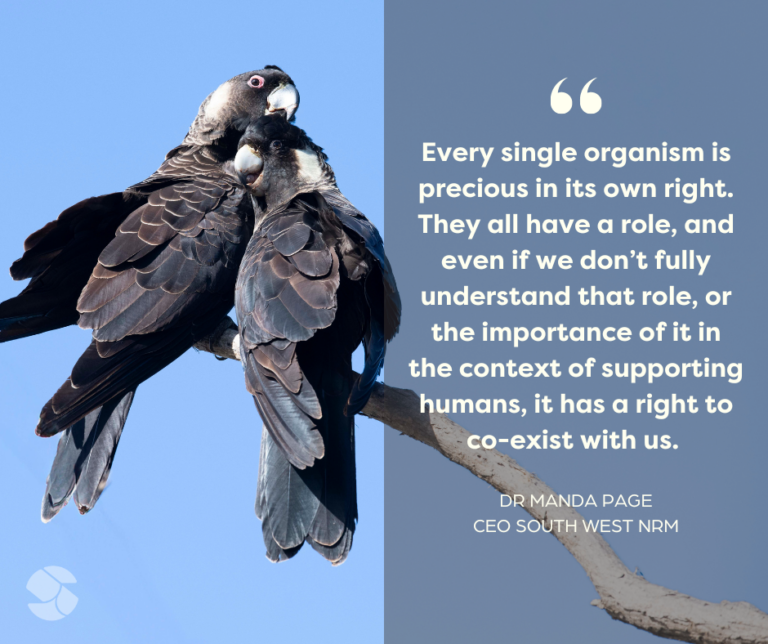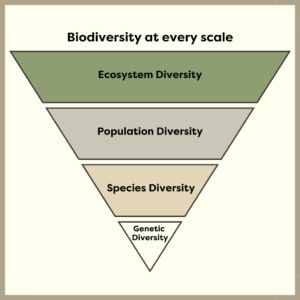
Photo by wildlife photographer Justin Cally.
Article by Dr Manda Page
Around the same time that I was listening to Cyndi Lauper and wearing leg warmers, a new buzz word was emerging in the field of environmental conservation work – Biodiversity.
It was basically a short-cut for the more  widely accepted scientific term ‘biological diversity’. Use of the term ‘biodiversity’ caught on pretty quickly and it’s one we are all familiar with.
widely accepted scientific term ‘biological diversity’. Use of the term ‘biodiversity’ caught on pretty quickly and it’s one we are all familiar with.
I have now spent more than 35 years working in the field of conservation across two Australian states. In my world, the drastic decline of biodiversity is a significant focus. It’s a critical issue that nations, governments, organisations and individuals around the world are grappling with.
My experience has illuminated 4 key objectives we should be striving towards for reversing biodiversity decline but first…
What does biodiversity really mean?
Biodiversity basically describes the variety of all living things.
Sounds pretty simple right? Except it’s not, mostly because true biodiversity is really difficult to measure. And how do we manage (or improve) what we can’t easily measure?
The tricky part is biodiversity isn’t one dimensional and it occurs at different scales. We need diversity at the genetic scale, the species scale, the population scale and the ecosystem scale.

Commonly, we use the number of species in a defined area as a surrogate measure for biodiversity. It’s a fair and useful standard approach but really, it simplifies the concept far too much.
Here’s an example to explain what I mean: A desert ecosystem may have a lower number of species (or species diversity) when compared to an equally-sized patch of rainforest.
But in conservation terms, the desert’s lower diversity – according to number of species – doesn’t make it any less healthy or important in terms of its contribution to life on earth, since we also need a diversity at the ecosystem level.
Why biodiversity is important
The point here is that biodiversity is the diverse and complex web of life that supports our planet and enables us all to exist. When we begin losing parts of that intricate and complex web, like species extinction (100 extinctions in Australia since colonisation that we know of!) things will start to fall apart.
The benefits to humans from biodiversity are clear. Some of these benefits are really obvious and directly linked such as economic benefits (like timber harvesting or fishing), ecosystem services (clean air and water or pollination of crops), health benefits (places to recreate and rejuvenate), and scientific value (new medicines).
Other benefits are more indirect and nuanced. What this all means is we can’t just commit to protecting and nurturing the parts of nature we feel we gain the most obvious and direct benefit from. The truth is we can’t possibly comprehend this intricate web of life and the potentially hidden value of each and every part. The reality is, it could be the loss of a microscopic and seemingly insignificant species which triggers a catastrophic ecosystem collapse.
On a personal note…
My personal view is that every single organism is precious in its own right. They all have a role, and even if we don’t fully understand that role, or the importance of it in the context of supporting humans, it has a right to co-exist with us.
The 4 key objectives
Having now been involved in trying to create programs and strategies to protect biodiversity across two Australian states, I still feel we are not doing it justice. But I have landed on some key principles that I am currently using to guide work in my role as CEO of South West NRM:
- Protect what we have left;
- Mitigate the threats;
- Actively restore and recover the species and habitat in trouble, and
- Help people understand the value more.
These are not achievements which can be delivered by Governments alone. Fundamental to improving biodiversity is a unified effort by non-government organisations, community groups, First Nations people, land managers and individuals along with the science that underpins and guides all of our efforts.
How you can help
We can all do our part, even if you don’t work in the environment sector.
A very good place to start is to be informed so with that in mind, I hope you have found this article of help. Please do consider sharing it within your networks and signing up to receive our monthly e-newsletter for further learning.
For more information on environmental conservation work by South West NRM over 20 years, please visit the below page of our website.
